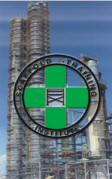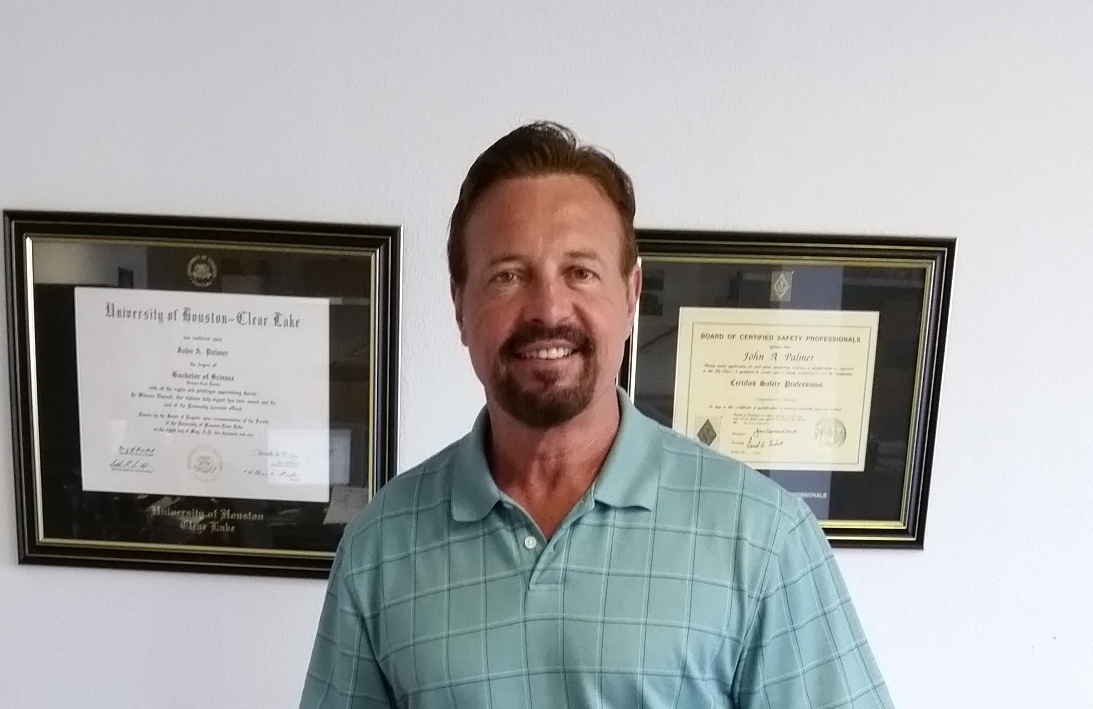


311 East Walker Street
League City, Texas
281-332-1613
CURRICULUM VITAE: JOHN PALMER, CSP
AREAS OF EXPERTISE:
-
Scaffold and Fall Protection Safety including:
-
Scaffold and Fall Protection Training
-
Scaffold Design, Construction, and Use
-
Fall Protection Systems
-
Regulations and Industry Accepted Practice
-
Multi Employer Worksite Issues
-
Employee/Subcontractor/General Contractor Relationships
-
Gap Analysis and Site Audits
WORK EXPERIENCE:
1991-Present: Director, Scaffold Training Institute.
STI is a leading worldwide provider of scaffold safety training services for the erection, inspection, and safe use of scaffolding. STI’s clients are worldwide, and Mr. Palmer has conducted training in all 50 states, China, and the Middle East. Clients include universities, industrial and commercial contractors, petro-chem, power, paper, and manufacturing facilities, apprenticeship schools, contractors’ associations, and safety associations.
Mr. Palmer responsibilities include authoring the curriculum materials including scaffold and fall protection training manuals, DVD’s, Power Point presentations, Videos, CBT CD-ROM training programs, and hands-on style training procedures.
He has conducted hundreds of safety training seminars including scaffold competent person, construction site fall protection, scaffold and fall protection hands-on, scaffold design, scaffold loading, suspended scaffolds, general OSHA jobsite safety regulations, and OSHA record keeping. He has also assisted in the instruction of OSHA training seminars through various OSHA Education Centers.
He provides general safety consulting services, such as company safety program evaluation, risk assessment audits, accident investigation, citation consultation, and litigation consulting. He has conducted dozens of investigations of scaffold and fall accidents, including having been hired by OSHA as an expert witness on their behalf.
Other responsibilities include design of unique scaffold projects, scaffold product design, manufacturing, and he has patented scaffold safety products.
1990-1991: General Manager, Scaffolding of Great Britain, Southwest US Region. Responsibilities included supervision of six scaffold companies in Texas involved in the engineering, design, manufacture, sale, lease, erection of scaffolding, contract review, and overall safety of employees and jobsites. These operations produced over ten million dollars in revenue annually, and employed several hundred personnel. Mr. Palmer was responsible for negotiating, signing, and administering contracts between facility owner/general contractor/subcontractor. As a subcontractor, his management duties included overall responsibility for employee safety issues including scaffold erection, fall protection, confined space entry, hazard communication, electrical safety, volatile atmospheres, material handling, ergonomics, rigging, falling object protection, personal protective equipment, loss prevention, safety audits, and other topics. He also had responsibility for contract performance, multi-employer worksite interaction, and final completion and payment. He has had overall responsibility for the safety and health of hundreds of employees involved in manufacturing, distribution, and construction.
1983-1990: Owner of Palmer Scaffolding, Inc. (PSI was purchased by SGB in 1990). Responsibilities included design, engineering, rental, and erection of thousands of scaffolds. He was also responsible for contract review, safety program development, implementation of all aspects of the safety program, as well as all occupational health issues. Mr. Palmer was responsible for negotiating, signing, and administering contracts between facility owner/general contractor/subcontractor. As a subcontractor, his management duties included overall responsibility for employee safety issues including scaffold erection, fall protection, confined space entry, hazard communication, electrical safety, volatile atmospheres, material handling, ergonomics, rigging, falling object protection, personal protective equipment, loss prevention, safety audits, and other topics. He also had responsibility for contract performance, multi-employer worksite interaction, and final completion and payment. He has had overall responsibility for the safety and health of hundreds of employees involved in manufacturing and construction.
1981-1982: Employed by SGB. Responsibilities included estimating, contract manager, and managerofscaffolding branches. Employed for six months by Kwikstage scaffolding.
EDUCATION:
University Credit, over 210 hours, including the following:
Bachelor of Science in Occupational Safety and Health, Summa Cum Laude, School of Natural and Applied Sciences, University of Houston at Clear Lake.
Occupational Safety & Health Curriculum included:
Advanced Mathematics, Statistics, & Calculus, Physics, Techniques of Safety Engineering and Analysis, Personal Protective Equipment: (Use of PPE systems including helmet, Eye protection, respirator, SCBA, Suits, Fall protection, footwear, etc.), General and Organic Chemistry, Industrial Health and Hygiene: (Hazards of the workplace including occupational exposure limits of airborne contaminants, epidemiological issues, sampling of gases, biological monitoring, PEL, REL, TLV, WEEL, OEL, Biomechanics, ventilation, respiratory protection, program management, etc.), Accident Investigation: (Various formal techniques of accident investigation), System Safety (Techniques of system safety analysis and accident investigation and prevention), Analysis of Fall Protection Equipment: (Study of and thesis on personal fall arrest systems), Environmental Biology: (Study of life forms, interaction, and environmental impact, effect of human action,), Environmental Chemistry: (Study of Chemical processes in the environment, water, air, contaminants, pollution and biological effect on humans), Environmental Geology, Industrial Ventilation: (Study of hazardous airborne contaminants, gases, and vapor, and removal through mechanical ventilation systems), Human factors and Workspace Design: (Ergonomics, study of the human body and workplace design, NIOSH lifting, cumulative trauma disorder, biomechanics, safety program analysis for ergonomic workplace design), Industrial Hygiene Sampling: (Analysis Equipment and procedures for sampling of air for various harmful contaminants, vapors, gases, and oxygen content), Environmental Toxicology: (Study of poisonous effects on humans of chemicals, contaminants, pollutants, heavy metals, including cancer, cerebral, liver, kidney, homeopathic and other anatomical systems), Noise and Hearing Conservation, Industrial Radiological Health: (Types of radiation, human biological effects, wave atomic, and molecular effects, protective measures, allowable doses and measurement).
Engineering Courses include:
Engineering Physics I, Engineering Physics II, Calculus I, II, & III, Differential Equations, Linear Algebra, Engineering Mechanics I: (Statics, Vectors, Torque, Couple, Resultants, Structures, Centroids, Friction, Virtual Work, Beams, Cables, Fluids)), Engineering Mechanics II: (Dynamics, Gravitation, Rectilinear motion, curvilinear motion, polar, normal and tangential coordinates, Force, mass, acceleration, work, kinetic energy, potential energy, linear impulse, linear momentum, angular impulse and momentum, kinetics, relative velocity and acceleration, motion relative to rotating axis, dynamics of rigid bodies, vibration, time response), Engineering Computing, Mechanics of Deformable Solids: (Stress, Strain, Sheer, Torsion, Moment, Poisson, and Deflection), Structural Analysis: (Determinate and Indeterminate Structures, Beams, Trusses, Frames, Bridges, Deflection analysis, Integration from load, sheer, moment, rotation slope, deflection, moment area, conjugate beam, Force, and other techniques), Engineering Strength of Materials: (Steel, Aluminum, Wood, Plastic, Stress, Strain, Modulus of Elasticity, Elastic, Plastic and Fracture load limits, Molecular configuration and crystalline structure of steel), Geo-Technical Engineering: (Soil loading), Techniques of Safety Engineering: (Facility design and operation to meet safety standards such as fire prevention, electrical, traffic, elimination of hazards through design, employee behavior modification, fall protection, etc. NSC Accident Prevention Manual), Structural Steel Design: (AISC Load and Resistance Factor Design of Building and Structures including Columns, Beams, Capacity Determination, Uniform Building Code Design Specifications), Mechanics of Fluids: (Static, Dynamic, and Open Channel Flow pressures and forces, Energy Equation, Momentum Equation, Pipe Networks, etc.), Design of Concrete Structures: (Foundations, Columns, Beams, Slabs, ACI 318).
Masters Level Civil Engineering Courses:
Design of Temporary Structures: (Scaffolds, Formwork, & Shoring), Structural Design using Matrix Analysis: (Stresses, Deflections, etc., of trusses, beams, and frames using Matrix techniques implemented through Computer based Structural Analysis programs), Building Construction Systems: (Structural Systems and Loads, Substructure systems, Reinforced and Pre-stressed Concrete, Steel Systems, Building Construction Systems Steel Systems including frames, trusses, tubes, cold formed elements, composite and mixed steel concrete, Special Structures including domes, shell and cable systems).
Business Courses include:
Business Law, Statistics, Accounting, Money & Banking, Micro and Macro Economics, Business computing.
Other Training includes:
1. OSHA 500 General Construction Safety Trainer Course (Assisted in Instruction for OSHA Training Institute)
2. OSHA 311 Fall Protection course (Four days, assisted in instruction for OSHA Training Institute).
3. OSHA 502 Update for Trainers (Three days, assisted in instruction for OSHA Training Institute).
4. OSHA 845 Recordkeeping (Taught for OSHA Training Institute)
5. OSHA 10 hour General Construction Safety Course (Taught numerous times).
6. Purdue University: Scaffold Erection and Safety course (40 hours).
7. Scaffolding Industry Association scaffolding seminars.
8. ASSE Safety Presentations.
9. NIOSH Scaffold Fall Protection Seminar *by invitation
CERTIFICATIONS:
1. Board Certified Safety Professional ( CSP ) #16845
Board of Certified Safety Professionals, (BCSP), Savoy, IL. BCSP is sponsored by the American Society of Safety Engineers, the American Industrial Hygiene Association, the National Safety Council, the System Safety Society, the Society of Fire Protection Engineers, and the Institute for Industrial Engineers.
This extremely challenging certification requires a college degree, several years of confirmed experience as safety professional, personal references, and successful completion of two board exams over curriculum including advanced mathematics, statistics & calculus, safety engineering, chemistry, physics, applied sciences, mechanics, reliability/probability, fire prevention, safety program (development, management, and evaluation), equipment and facilities safety, structural design, environmental requirements, electrical safety, hazard analysis, epidemiology, OSHA regulations, legal aspects, professional conduct, ergonomics, industrial hygiene, ventilation, behavioral science and modification, disaster control and planning.
This certification is recognized without challenge as the premier certification for occupational safety and health professionals.
2. US DOL OSHA 500 Instructor
Certification for OSHA’s Construction Safety Courses (1991). Authorized to conduct OSHA’s 10 and 30 hour general construction safety courses.
BOOKS/MANUALS AUTHORED:
American Society of Safety Engineers’ “Construction Safety Management and Engineering” Scaffold Safety Section
The Scaffold Training Institute’s “Scaffold Competent Person/Scaffold Builder” Learning Guide (original 1994, revised 1996, 1998, 2000, 300 pages).
The Scaffold Training Institute’s “Scaffold User Course Learning Guide” (1996, 100 pages).
The Scaffold Training Institute’s “STI’s Guide to Personal Fall Arrest Systems” (2000).
Spider Suspended Scaffolding “Suspended Scaffold Competent Person Training Manual” (2000, 400 pages).
PUBLICATIONS:
Mr. Palmer has written or contributed to articles in the following publications:
National Safety Council’s “Safety+Health” magazine.
National Safety Council’s “Construction Division Newsletter”.
“Occupational Hazards” magazine.
Scaffold Industry Association’s “Scaffold Industry” magazine.
“Contractor Tools and Supplies” magazine.
American Society of Safety Engineers “Construction Safety Management and Engineering”
SPEAKING ENGAGEMENTS AND SEMINARS CONDUCTED:
Mr. Palmer has been asked to give presentations on scaffold safety by:
National Safety Council,
American Society of Safety Engineers,
Texas Safety Association,
Numerous local and state safety associations,
Industry groups,
Has conducted training for OSHA Training Centers.
Since he typically conducts three to five seminars a week, space will not permit reprinting of the entire list here. However, a complete list of clients who have used STI products and services, as well as seminars conducted by Mr. Palmer, is available upon request
MEMBERSHIPS:
American Society of Safety Engineers.
Underwriters Laboratory/ANSI Standards Technical Panel 1322 “Fabricated Scaffold Planks and Stages” *by invitation.
National Safety Council.
Scaffold Industry Association.
Texas Safety Association.
American Society Of Civil Engineers.
MISCELLANEOUS:
Mr. Palmer's qualifications include a broad range of experience in the scaffolding industry. He has been involved in the design, engineering, manufacture, erection, rental of scaffolding, management of scaffolding companies, and scaffolding consulting and safety instruction for over twenty five years.
He has received extensive training from the scaffolding companies he has worked for, including some of the largest scaffolding companies in the world. True scaffold expert training can only be obtained by working for several years in the scaffold industry for manufacturers, designers, and erectors.
He has been the General Manager of scaffolding companies employing several hundred personnel involved in the design, rental, erection and manufacture of scaffolding. He has owned a scaffolding rental and contracting company. He has held the following positions in the scaffolding industry: erector, foreman, construction manager, designer, estimator, general manager, owner, safety trainer, consultant, inventor, and expert witness. He has invented and patented scaffolding products. He has had overall responsibility for the safety and health of hundreds of employees involved in manufacturing, distribution, and construction.
He has been involved in fall protection, scaffold, and construction site safety training exclusively for over fifteen years. He has conducted thousands of training seminars worldwide.
He has been hired by the US Department of Labor, the Office of the Solicitor, and as an expert witness on behalf on OSHA. The National Institute for Occupational Safety & Health (NIOSH) invited Mr. Palmer, along with other national experts, to participate in a symposium on fall protection on scaffolds. He was asked by Underwriters’ Laboratories to serve on the UL/ANSI technical board for scaffold stages.
![]()
For questions or comments, please contact Scaffold Training Institute at info@scaffoldtraining.com
![]()
Scaffold Training Institute
311 East Walker
League City, Texas 77573
Voice: 281-332-1613
Fax: 281-316-2030
|